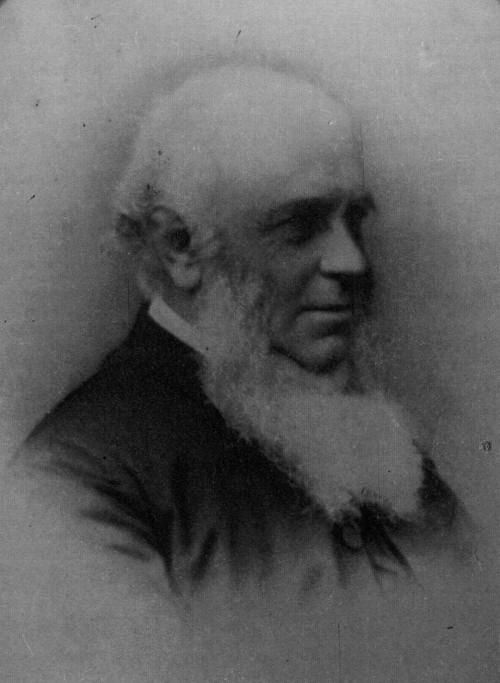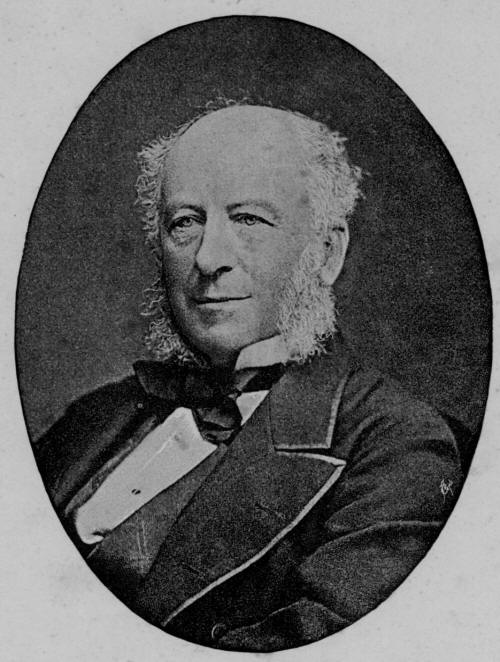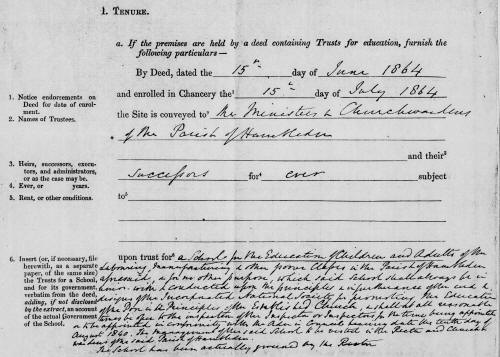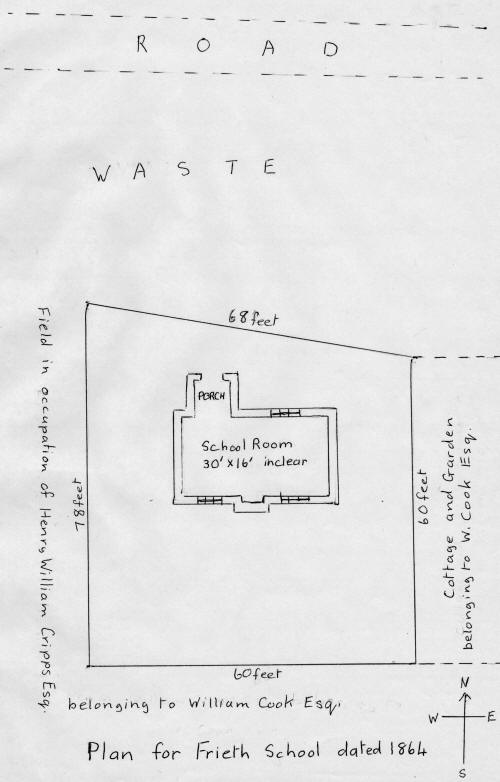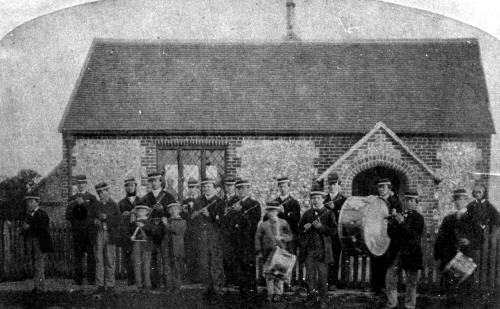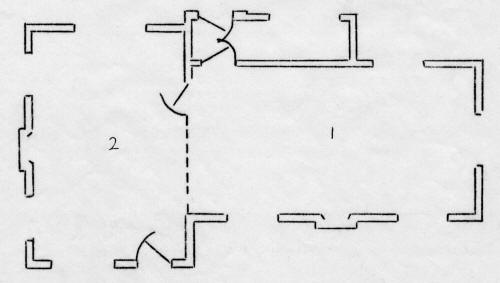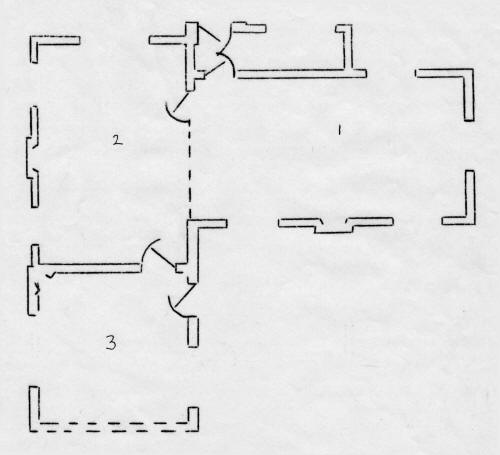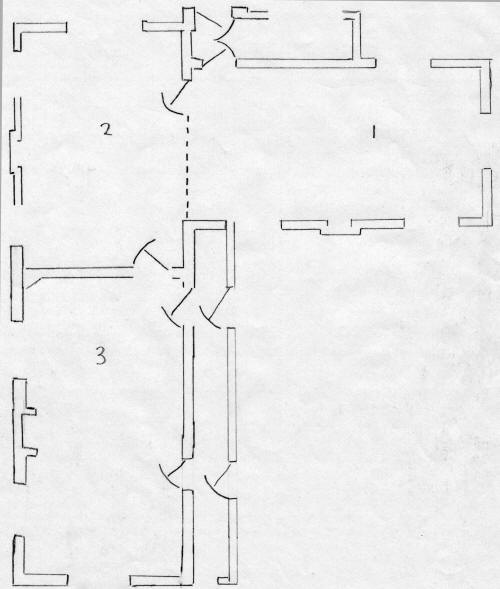Frieth School |
The Early Years : 1865 - 1898 |
||||||||||||||||||||||||||||||||||||||||||||||||||||||||||||||||||||||||||||||||
|
Introduction
Preface The Early Years : 1865 - 1898 The First Headteachers The Years : 1898 - 1906 Mr & Mrs Derry : 1906 - 1930 Mrs Hinton : 1931 - 1941 Miss Browning : 1942 - 1943 Mrs Garrett : 1944 - 1952 Sep 1952 - Apr 1953 Mrs Davies : 1953 - 1960 Mr Cox : 1961 - 1965 Mr Carpenter : 1965 - 1985 Appendices Admissions register School Staff : 1865 - 1985 School Roll : 1870 - 1993 |
Frieth School was opened officially on Wednesday 19th April 1865.
However, this does not mean that there was no local provision for the education
of Frieth children before this date, nor that from this date all the village
children had the benefit of schooling.
During the first half of the 19th Century the women of Frieth and Hambleden supplemented their income by making and selling pillow lace. This trade had been fostered by the two rectors of Hambleden, H.C. Ridley and W.H. Ridley, father and son, who saw it as a way to alleviate the poverty of their parishioners. The earlier a girl learnt this craft the better she was able to attain the necessary speed with the lace bobbins. Older women set up lace schools in their homes where they taught lacemaking and also gave some instruction in reading and counting to girls and small boys. In 1837 a National School had been built at Hambleden (the present parish rooms) and between this date and 1865 children from any part of the parish of Hambleden whose parents felt they could benefit from further learning, and could pay towards the cost, could send them to Hambleden School. [ The Victoria County History differs slightly on the dates see : VCH : Hambleden : Educational Charities ] The 1851 census figures for the Frieth area list 59 children aged between 4 and 12 inclusive, and call 32 of these 'scholars' (Note 1) Of these 32, 15 girls and 12 boys of 7 years and under would most likely have been lace school 'scholars'. The other 5 boys who may or may not have travelled to Hambleden were the sons of "a farmer of nine acres, a road surveyor, a soldier's widow and a farm (Note 2) By 1861 the child population of Frieth aged 4 – 12 years had risen to 100. At that time Rev. W.H. Ridley was Rector of Hambleden who, like his father before him, was a progressive cleric convinced of the necessity of improving the lot of his parishioners both in body and in mind. He it was who had the Chapel of Ease built at Frieth in 1848, the present Frieth Church of St John the Evangelist.
Finding land for a school In 1864 Rev. Ridley set to work to find a site and, by subscription, raise the necessary cash to erect a school building in Frieth. The school was to be set up "in accordance with the National Society for the Promoting of Education of the Poor in the Principles of the Established Church throughout England and Wales", as had been Hambleden School. Rev. Ridley was assisted in this task by Mr. and Mrs. H.W. Cripps who had moved into Parmoor House in 1860 with their young family, and who were philanthropic gentry keenly interested in education and the village of Frieth in general.
Mr. & Mrs. Cripps were tenants of a Mr. William Cook who was living on the southern outskirts of London. Mr. W Cook owned not only Parmoor House and the estate surrounding it but also land in Frieth village; it was he who gave a small piece of land in the corner of a meadow called Hither Friethe (Note 3) to "The ministers and churchwardens of the Parish of Hambleden and their successors for ever" (Note 4)
Original plan of 1864 The following is a list (Note 5) of the subscribers to the Frieth School Building Fund :
The following quotes from the Hambleden parish Magazine show the progress of the building : September 1864 : "Everything is ready for the commencement of the new schoolroom at Frieth, but it is feared that the commencement must be delayed for want of water, unless we shortly have abundance of rain" October 1864 : "The schoolroom at Frieth has made good progress, it is partially roofed in." March 1865 : "Frieth schoolroom is now completed, with its wood-house and fences, and fire are constantly kept in to dry the plaster and make it ready for the children to assemble in it. Saturday 25th March is the day fixed for its public opening (Lady Day)." April 1865 : "The opening of the new schoolroom at Frieth has been postponed till April 19th." May 1865 : "This long looked for event took place on the Wednesday in Easter Week April 19th. The day was very favourable, though the N.E. wind blew rather keenly over the high grounds. "The ceremony commenced with Evening Prayer in Frieth Chapel at 3 p.m. Precisely at that hour a procession consisting of the Frieth singers and the Clergy (in surplices) and wound up by the Rt. Rev. the Bishop Coadjutor of Edinburgh, entered the chapel chanting Psalm cxxii. The prayers were intoned by the Rev. E.S. Wilson and the Rev. F.A.G. Eichbaum, the Lessons (Proper for the occasion I Samuel iii 1-10 and 2 Timothy iii 9 to end) being read by the Rev. R. Milman and the Rev. C. Warner. A very simple and appropriate Sermon was preached by the Bishop. The chanting and singing was very creditable considering all was in unison. The collection after the service amounted to £3-14-0 [ Note 6a ] "As soon as the service in Church was ended a procession moved from the Church to the Schoolroom, headed by the School Children. The Procession Psalm was Ps cxliv The clergy occupied the east End of the schoolroom, the Bishop being in the centre; on each side were the Frieth Choir, the males on one side, the females opposite them. The room was soon filled by an assembly of the infants belonging to the school, the gentry and the parents of the children. Ps. Viii was then chanted. A lesson was read by Rev. T.A. Powys (Prov. Ii 1-6), Hymn cvii (note 6) was sung, a few short prayers said by the rector and the bishop, a concluding prayer for the clergy by the Rev. J. Baines (Diocesan Inspector) and the Bishop dismissed the congregation with his blessing. "When the ceremonies were concluded the children, as well as any of their friends who were present, were regaled with a sumptuous repast of tea, cake, bread and butter and bread and jam, the gift of Mr. & Mrs. Cripps, who also with all their family attended to wait personally on their numerous guests. The Bishop, Clergy and gentry were also entertained in a most hospitable manner at Mr. Cripps home. "The Chapel and Schoolroom were both decorated very prettily and tastefully with evergreens, flowers and inscriptions. "A blue flag furnished by Mr. Cripps's kindness waved triumphantly from the front of the school. "Among the company present, besides the Bishop and clergy who have been already named, there were Vice-Admiral then Hon. G. Grey, Mrs. Grey, Miss Stewart, Mr. & Mrs. Cripps with all their family. Miss Ryder, Mrs. Wilson, Miss Proctor, Rev. E. & Mrs. King, Rev C.W.B. Clarke, Mr. Toovey and Mr. & Mrs. J. Toovey etc. "The day will long be remembered at Frieth as a day of unmixed pleasure and happiness." The Original Schoolroom This original schoolroom was just one room, 30 feet by 16 feet (now (1985) the school hall/dining room) and was heated by an open fire. The small building attached to the main room on the east end served as 'The Offices'.
For several years prior to 1865, Mrs. West had carried on a school in her Cottage (now Flint Cottages (rear), belonging to Mrs. McNeill). This was a Lace School, but may have given somewhat more instruction in reading and counting than others, because Rev. W.H. Ridley appointed Mrs. West as the first School Mistress of this new Frieth schoolroom. Mrs. West's son Tom was to help her, probably on a part time basis. One can imagine the children walking across the Village Green from the cottage carrying their slates and Primers. Our early records give no indication of how many children there were, their names nor how many were full or part time scholars. It appears from references to 'lace girls' that the older girls only attended school in the afternoons or early evening. By 1867 the Factory Acts stated that no child should be employed under 8 years of age and all children between the ages of 8 and 12, who were employed, must attend school for 10 hours per week, paid for by their employer out of the child's wages! After reading some letters dated 1870, retained among the early school papers, it appears that parents were still unwilling to comply with this Act and accept the fact that their children were 'employed' whilst helping father by scaring crows, stone picking, cow minding, wood chopping or helping mother lacemaking! This Act was followed by a series of others successively raising the age under which a child might not be employed, from 8 years to 12 years. The only written evidence we have of how many full time scholars there were in these early years is a note written by an Inspector in 1870 stating that there were, on average, 35 pupils. Schooling for the first time scholars had to be part paid for by the parents, the deficit being made up by voluntary subscriptions from the general public. After 1870 a Government grant was given on the attendance (and later attainment) figures of the pupils. There is no record of what was said at first, but a note in the Parish Magazine for March 1874 says :
"Payment for School : By 1870 the population growth in England, and the upsurge of interest in education brought about the elementary Education Act of 1870. The Education Authority was charged with the duty of finding out whether or not, in every parish, there was a short-fall of school places, and providing School Boards in every district requiring more accommodation. At this time Hambleden Parish, having two schools, was pretty well provided for, but the school numbers were rising. The two-roomed school In 1872 the average attendance at Frieth was 65, so a Government Grant of £25-6-0, for the year, was paid on the attainment as well as the attendance of the children. Rising numbers made it necessary to add another room to accommodate the extra pupils and in 1873 a front porch and cloakroom, paid for by the Cripps family. Mr. Corby of Great Marlow, builder, took on the contract. Unfortunately the flintwork is not up to the standard of that of the first schoolroom.
( A movable wooden and glass partition separated the two rooms later - 1912) The following extracts from the Parish Magazines of June and August 1873 give an interesting side light on the school extension! June 1873 : "During the School enlargements the children assembled at Cutler's Farm House (Note 7) by the kindness of Mr. Toovey and of Charles Leaver and his wife." August 1873 : "Frieth School additions have been completed. There is abundance of room for the Infants and the Lace-making girls can be admitted as half-timers. We are grateful to Charles Jones and his wife at Cutlers Farm for providing the School mistress and her pupils an asylum in their house while they were kept out of the school room and to Mr. Toovey for the use of his barn." The Elementary Education Act of 1876 made it the duty of every parent to see that his child received sufficient instruction in reading, writing and arithmetic. If the child could pass the 4th standard before he was eleven years he could have further education free. Every child of not less than 5 years and not more than 13 years must attend school unless he could pass the 'Labour Exam' at 12 years of age. A second Act in 1880 made the system of universal compulsory education complete, but not free until 1891. These Acts of 1876 and 1880 aroused antagonism in many parents countrywide and caused gross overcrowding, poor attendance and many unwilling scholars in schools. The 1877 Frieth School Schedule lists 72 pupils who had enough attendances to be examined at a certain standard. By 1878 there were 105 children between the ages of 4 and 11 on the books, plus 6 who were 12 years, 2 who were 13 and 2 who were 14. In all 115 children in two rooms, Teaching conditions must have been very difficult, for the records make constant reference to poor ventilation, lack of light in 'The Offices', shortage of desks, desks too large for the infants, smoking fires and overcrowding. There is reference too to "The Infants Gallery". This was a series of wooden steps on which the children sat in rows with slates and primers. The school grows further A third room was eventually added (although there is no reference to it – possibly in the 1880s) ( There is no record of the configuration of the south wall ) The third room was extended in 1895; the builder of this extension was Mr. George Smith, and the exterior flintwork is one of the best examples of this craft in the neighbourhood; a second cloakroom was added and the 'The Offices' improved. Poor attendance Constant references are made in the first School Log Book to poor attendance (about 75% seems to have been normal) and a variety of reasons are offered for this low figure. Aug 12th 1892 : "Many children have been absent and others irregular this week. The Harvest having begun in several places" May 31st 1893 : "Seven Skirmett children are gone home this afternoon to see a cricket match" Feb 27th 1893 : "Four girls from Moor End were absent in the afternoon, stopping away from school on purpose to come to Frieth at 3 o'clock to see a funeral. Just mere curiosity, they were observed to be waiting in the wet for nearly an half an hour. This incident is mentioned to show what unreasonable and frivolous things afford an excuse for absence. The parents are much to blame for this" May 30th 1893 : "The attendance office supplied with a list of Skirmett (Note 8) and other children who are very irregular." Nov 7th 1898 : "Mr. H. Barksfield, Attendance Officer, visited the school and took a long list of absentees. Several were being illegally employed minding cows." May 22nd 1896 : "One girl in the Marlow School Attendance District who lives over two miles from the school has been playing truant and taking with her seven other children." "One Standard 5 girl has been absent all the week nursing the baby." Inclement weather caused a lot of absence and sometimes necessitated school closure : Jan 14th 1895 : "A heavy snowstorm, roads impassable, no school this morning." (The bad weather continued throughout the rest of January and most of February) By far the biggest cause of absence was illness, coughs and colds, whooping cough, measles, typhoid fever and scarletina. Scarletina was the worst and necessitated the school being closed in 1894 for two separate months - February and April. By order of the Sanitary Inspector the whole school was disinfected, painted and white washed. There is no mention of the physical wellbeing of the children until 1879 when remarks were added against their names on the yearly Examination Schedule e.g. "Not clean", "Not very clean", "Not very tidy", "Hands dirty", "Untidy hair". In 1880 there is a list of children who received gifts of clothes – these were awarded to those who had made the most attendances during the year, which would seem more a form of 'bribery' than an attempt at welfare! The children received coats, caps, suits, shirts, trousers, scarves handkerchiefs, socks, stocking, flannel petticoats, aprons and braces. The records do not say who gave these presents, but possibly they came out of the Parish Charities (Pithouse Monies) (Note 9) Increasingly it appears that Frieth looked to the Cripps family for charity, large and small. Mr. H.W. Cripps paid for the majority of the work done on the second school room added in 1873 and for the extension on Frieth Church. "Two buns and an orange for each child at Christmas from Mrs. Cripps" etc. In 1898 Mr. C.A. Cripps (Lord Parmoor, 3rd son of H.W. Cripps) was the chief subscriber to the fund for building the Village Institute at Frieth, adjacent to the School. This was of great benefit to the School, as well as the Village, as often the evening events carried on in the School had been a source of annoyance and inconvenience to the School Staff. The Log Book says : April 29th 1895 :"Some complaint has been made that the School has not been quite so clean as it should be. There is truth in this, it has not been offtimes so clean as one could wish, but there are great difficulties in the way. For many weeks during the winter season there has been as many as 13 evening meetings held in the school viz: 6 Reading Room, 2 Band Practice, 1 Nursing Class, 2 Sewing classes, 1 Drawing class, besides choir practice, and as often during the winter the ground around the school is a quagmire, a great quantity of mud is brought in, more in the evening than during the day time." and again : "The Rector's attention has been called to some ill usage of the school desks when a social entertainment was being held on Monday night." Click to go on to the next chapter "The First Headteachers" Notes: (1) The term 'scholar' may merely have been applies by the enumerator to all children under the age of 12 who were not working. (2) I have not been able to check the names against Hambleden School records as they do not appear to have survived. (3) Hambleden Tithe Map and schedule 1845 (4) Quoted from a form filled in by W.H. Ridley dated 10.9.1870 retained with Frieth School Records. I have never seen the original deed [1985] but Rev. W. Watts took it out of the Hambleden Church safe in 1964 and quoted from it to me and Mr. D. Cox. [This deed has since been lodged with the Diocese of Oxford, the school has a copy, reproduced above ] (5) This list is copied from the Hambleden Parish Magazine (6) So far all efforts have failed to find the hymn book used
[ (6a) Psalm cxii "I was glad when they said unto me, Let us go into the house of the Lord" (7) Cutler's Farm was previously called Friethe Farm and is now known as Collier's Farm. (8) Little wonder, as the Skirmett children has to walk two miles uphill to Frieth and then two miles back. There was an infant school at Skirmett for the children under 7 years of age. There are constant references to the backwardness of these children when admitted to Frieth at 7 years. (9) In 1965 I was talking to an old lady of over 80 who had always lived in Skirmett and had attended Frieth School about 1890-95. I asked her what kind of clothes she wore to school in those days (without realising that, at that time, Skirmett was the 'poor end' of the Parish), she laughed and, with a little sly glance at me, replied "Us wore most what us could git holt on, but ollus tipy toed shoon." What she meant was that her clothes were usually second hand and her shoes from the Pithouse Charity, hand made by my husband's grandfather at Frieth. The 'tippy toes' were metal plates attached to the toes and horse shoe shaped metal to the heels – very necessary to make the shoes last longer up and down the rough road from Skirmett to Frieth. |

